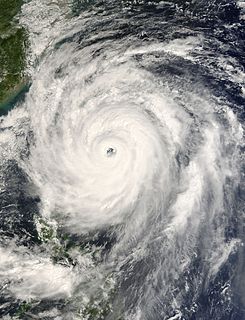The name Karen has been used for seventeen tropical cyclones worldwide: six in the Atlantic Ocean, nine in the Western Pacific Ocean, one in the South-West Indian Ocean, and one in the Australian region.
The name Betty has been used for a total of twenty tropical cyclones worldwide: one in the Atlantic Ocean, two in the South Pacific Ocean, one in the South-West Indian Ocean, and sixteen in the Western Pacific Ocean.
The name Flossie has been used for one tropical cyclone in the Atlantic Ocean, seven tropical cyclones in the Eastern Pacific Ocean, and nine tropical cyclones in the western Pacific.
Tropical Storm Gay may refer to the following:
The name Isang has been used for sixteen tropical cyclones worldwide: fifteen times by the Philippine Atmospheric, Geophysical and Astronomical Services Administration (PAGASA) in the Western Pacific, and once by the Météo-France in the South-West Indian Ocean.

Typhoon Krosa, also known in the Philippines as Typhoon Ineng, was a powerful typhoon that impacted both China and Taiwan. The 18th tropical cyclone, the 15th named storm, and the 11th typhoon of the 2007 Pacific typhoon season, Krosa formed from a tropical system east of the Philippines in late September. The system became a depression on October 1, and on the following day, the depression quickly developed into a severe tropical storm. In the following days, Krosa rapidly intensified into a Category 4 super typhoon and reached peak intensity of 105 knots (194 km/h). Krosa would slowly weaken before making landfall on Taiwan. After making landfall on Taiwan, Krosa quickly weakened into a minimal typhoon, and rapidly weakened into a tropical depression between Zhejiang and Fujian provinces. Krosa transitioned into an extratropical cyclone on October 8. Extratropical remnants of Krosa dissipated on October 12.
The name Helen or Hellen has been used for twenty tropical cyclones worldwide: sixteen in the Western Pacific Ocean, one in the North Indian Ocean, one in the South-West Indian Ocean, and two in the Australian region.
The name Sinlaku has been used for four tropical cyclones in the Western Pacific Ocean. The name was contributed by the Federated States of Micronesia and means Kosrae, a legendary goddess.
The name Kim has been used for eight tropical cyclones in the northwest Pacific Ocean.
The name Virginia has been used for eight tropical cyclones in the Western Pacific basin.
The name Ineng has been used for five tropical cyclones in the Philippines by PAGASA in the Western Pacific.
The name Seniang has been used for twelve tropical cyclones in the Philippines by PAGASA in the Western Pacific. Seniang is a nickname for a woman.
The name Bising has been used for 14 tropical Cyclones in the Philippine Area of Responsibility by PAGASA in the Western Pacific.
The name Olive has been used for a total of eleven tropical cyclones worldwide: one in the Eastern Pacific Ocean, nine in the Western Pacific Ocean, and one in the Southwest Indian Ocean.

Typhoon Krosa, known in the Philippines as Typhoon Vinta, was a typhoon that made landfall in the northern Philippines in late October 2013. Forming on October 27 near Guam, the storm slowly intensified while moving westward. Krosa developed an eye and became a typhoon before striking Luzon on October 31. The storm weakened over land, but re-intensified over the South China Sea, reaching peak winds of 150 km/h (90 mph) on November 2 off the southeast coast of China. Typhoon Krosa stalled and encountered unfavorable conditions, resulting in quick weakening. By November 3, it had weakened to tropical storm status, and was no longer being warned on by the next day. In northern Luzon, Krosa damaged 32,000 houses, including 3,000 that were destroyed, and caused four fatalities. High winds and rainfall left ₱277 million in damage.
The name Luding was used for ten tropical cyclones by the Philippine Atmospheric, Geophysical and Astronomical Services Administration (PAGASA) and its predecessor, the Philippine Weather Bureau, in the Western Pacific Ocean.
This page is based on this
Wikipedia article Text is available under the
CC BY-SA 4.0 license; additional terms may apply.
Images, videos and audio are available under their respective licenses.

